By Jeffrey A. Rendall, Photos by Jeffrey A. Rendall
Note: This article, featuring former Wintergreen Director of Golf Sean Taylor, was written in 2009. The Wintergreen Golf Academy is now run by Taylor's colleague, Geoff Redgrave. The Wintergreen Golf Academy remains a great place to learn the game, or sharpen your skills.
WINTERGREEN, VA – “Two things,” remarked Wintergreen Resort’s Director of Golf, Sean Taylor, when I asked him what he and his staff hoped to accomplish with students attending their Golf Academy.
“First, we want everyone to have a really good time, and second, we want them to leave knowing a little bit more about how to hit the golf ball – and also, what they need to do on their own to keep progressing towards hitting the golf ball better,” Taylor added.
In a day and age when just about every golf resort or course offers golf instruction if not a golf school, Wintergreen Resort’s philosophy wouldn’t be considered unique. Every facility would strive to show their guests a good time, and every golf school wants you to go away better off for the effort – and money -- expended.
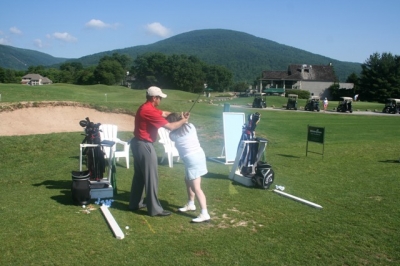 |
| Sean Taylor provides some hands-on advice while demonstrating swing fundamentals at the Wintergreen Golf Academy. |
With that being said, Wintergreen’s golf school experience still stands apart, mainly because of its video teaching software, known as the Model Golf system. The Model Golf experience begins with taking a series of measurements of your physical frame and adds data from a survey you provide of your swing and ball flight tendencies – and then superimposes a stick-figure ‘model’ on your video frame.
“Every golfer’s frame out there is completely different,” Taylor explained. “And the Model itself fits precisely into your own personal specifications. As we put in all these different measurements, the software essentially generates your ‘model’ and your perfect swing – knowing at the end of the day that it’s an elusive perfect swing.”
Perfection is indeed unobtainable, but the ‘model’ is based on those professional golfers who’re a good share closer to the ideal than you. The Model Golf system was designed by Olympic silver medal-winning Kinesiologist Dr. Ralph Mann, who was searching for a way during his running days to physically perfect the movements in his hurdling technique – which it turns out, also translated nicely to golf.
Taylor explains what motivated Mann to develop the system in the first place: “Mann literally finished second most of his career, so he was searching for a way to improve, to aid him in taking those incremental steps to go a little faster. He came up with the idea of filming all of the great hurdlers and analyzing their technique as it compared to his own. The end result was the ‘model’ hurdler.”
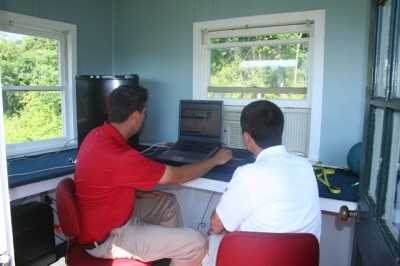 |
| Wintergreen Assistant Golf Professional Eric Woodward examines the Model Golf system's powerful analyzing capability - it's online, and it's easy to use. |
Mann also had a strong passion for golf – even to the extent of basing his college dissertation on the biomechanics of the golf swing. Mann put together the same sort of film analysis program for golf as he did with the hurdlers – he took the top 100 PGA Tour players each year and digitized their golf swings, measuring all of their movements and positions.
And when they were all mixed together in the computer software, the end result was the most ‘perfect’ swing that’s out there. The Model Golf system is about as scientific as it gets in terms of measuring and analyzing your own golf swing as compared to what it ‘could’ be.
In that sense, it works differently than other video golf tools we’ve seen and used in the past. We’ve seen our swings compared to various Tour players of like body frame, but the Model Golf system takes it one step further – showing you more precisely what you’re doing ‘wrong,’ and suggesting the moves you ‘should’ be making to do it correctly.
So even if you can’t play the Tour, your swing can at least ‘look’ like you belong there.
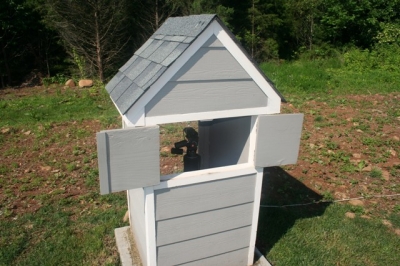 |
| Two cameras funnel your swing video to the Model Golf system, one to the front (pictured here), and one in back. Two different views for complete analysis. |
Of course it’s not that simple – the ‘model’ is just that, the ideal that you’re shooting for. Putting the lessons into practice is the hard part, and that’s what Taylor and the other instructors at Wintergreen (Eric Woodward also helped quite a bit with our school sessions) are there to help out with. Their ‘help’ comes in part by setting up your own Model Golf Website.
“The great thing about the Model system that sets it apart from other systems is that we establish, with the video we take of your own swing and all these great drills – your own personal Website that you can view at home,” Taylor said. “And within that Website is your own development plan, with all the drills we worked on (whether in text or video), and that way, we can continue giving back to the student.”
And while it’s true that a good portion of the Wintergreen Golf Academy experience revolves around the Model Golf system, this only tells part of the story. Having been to a few golf schools in the past, we wanted to try something different, and Wintergreen provided all the ‘curriculum’ choices we could ask for in terms of the type of school we wanted to try.
I’d never seen how a golf school would handle a beginning player, so my wife Shari and I decided on the Wintergreen Couples Golf School so that she could take up the sport the right way, learning how to approach the game taught by people who truly know how to play it.
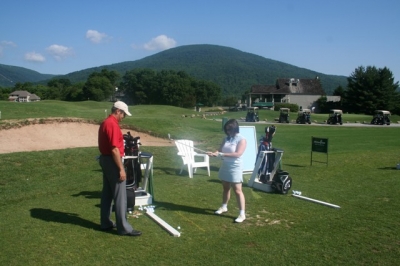 |
| It's hard to find a more beautiful setting for a golf school - it makes practicing golf a lot less arduous. |
Taylor says their approach is a bit different for someone who’s never played (or hasn’t played very much), but in the end, it’s all about playing better golf. “For a beginner, I think the most important aspect of a school experience is to help build the foundation which the golf swing is built upon – which is obviously your stance, grip, set-up and ball position. The idea is to develop some sort of consistency that they’re setting themselves up for success on a consistent basis before they go out on the course and swing away.”
That’s the ‘hump’ that Taylor talked about several times during the school, the point where every person is proficient enough in the basics to actually play a game on a golf course and enjoy it while not ‘penalizing’ others with slow play and an ignorance of the fundamentals of the game.
“The second part of teaching beginners is helping them actually develop some feel for where the club is when it’s swinging around the body – because it usually feels foreign to them,” Taylor lectured. “A lot of times we’ll get in there and help them swing and put them in position so they can feel it and hold those positions -- so they’ll grasp where the club should be on a given position during the course of that swing.”
For someone who’s played the game awhile (such as myself), the school’s emphasis was on accentuating the feel of the swing – putting the club in some different, more efficient positions so I could swing the club more effortlessly and most importantly, more predictably.
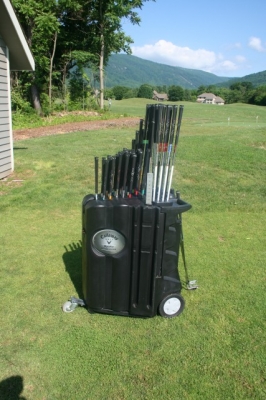 |
| Not only will you learn about your golf swing at the Wintergreen Golf Academy, you can also be fit for Callaway golf clubs. |
In other words, it’s all about ‘feel.’ Or, is it all about technique? “What we try to do first and foremost at our schools is to try and understand how all students learn, how they’re going to get the most out of this school. If you’re a technical-only guy, and Payne Stewart comes to your golf school – you know what, he’s not going to get much out of it because Payne Stewart is such a ‘feel’ player,” Taylor explained.
Technical learners will love the model system, because it includes all sorts of measurements, launch angles and graphics to help demonstrate the teaching concepts. It’s the perfect visual learning device for those who love to tinker with their golf swings – and if you want to switch your various positions, you can actually see how it’s done.
As mentioned above there are different schools that are geared towards different types of learners at Wintergreen. Taylor says separating the right-brained ‘feel’ players from the left-brained technical students is one thing they do very well.
Like most players who’ve played for many years and lacked a consistent practice routine, my swing had lapsed back to a place of comfort, which led to inconsistent results. True to his words, Taylor put me in some positions that really challenged me to make changes – and to hone them through practice.
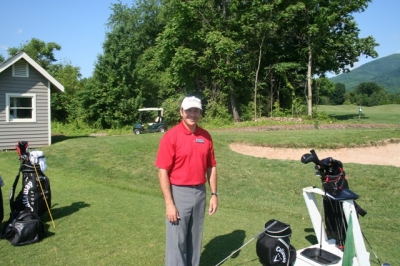 |
| Sean Taylor is not only a good instructor, he's a good guy, too. |
And that’s the biggest issue I’ve had with golf schools in the past – that I’d learn something and play great for awhile, but then find myself in almost a worse position (because of an inability to retain the lessons) than where I started.
Taylor says retention is certainly one of Wintergreen’s goals: “By coming here, you’ve already made a conscious decision to invest in your golf game. And with that, it’s kind of like an annuity – you put away a little bit every week and then when you retire, hopefully there’s a pretty significant nest egg there.”
Taylor continues, “The key is, coming out of golf school, to get right back out there and do it. It’s taking the journal that you have (they make one for you during the school), utilizing the Website that we give you, utilizing the drills that we talk about that help you feel all the different sensations that we’re trying to get you to feel when you’re here. It’s taking all that and consciously working on those things the next time you practice.”
“But at the end of the day, you just have to realize that it’s a game and it’s a sport – and that you have to be able to play the sport. And the sport isn’t ‘golf positions,’ it’s the number on the scorecard. That’s so incredibly important, because you have to train yourself on the driving range and then trust it enough to take it out onto the golf course,” Taylor concluded philosophically.
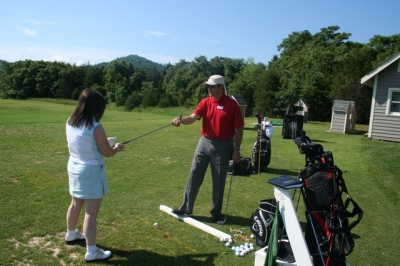 |
| Wintergreen has added additional space for its Golf Academy in recent years, and provides more than adequate space for teaching all types of golf shots. |
A final aspect of the Wintergreen Golf Academy experience is the playing lesson, though we didn’t take part in one – it’s probably best left to advanced players, or return visits to the school.
Taylor thinks the playing lesson is vital in helping every player get around the golf course, with the ultimate goal of helping you save half a shot per hole: “Not only will a playing lesson help you get yourself around the golf course a little more effectively, it’ll help you miss your shots in places where you can hopefully save a half a shot here and there.”
“If we can do that eighteen times, we’ve obviously reduced your overall score by nine shots – and it’s all just a matter of doing the right things that will give us the best possible score with what we are bringing to the golf course on that given day. If you’re to the point where you’re ready for the golf course, then the playing lesson is absolutely critical,” Taylor added.
It’s that little extra ‘game plan’ that so many of us neglect in playing golf. Too many of us are so concerned with worrying about what happened with the last shot that we’re unable to orient ourselves with the future – and the next shot in golf is always the most important.
 |
| After taking your shots on the practice tee, there's always the option of taking your new game to the course. Here, the view from behind the green of the Shamokin nine's 4th hole. |
To that end, we’ll let Taylor have the last words: “What we’d like you to do is get immersed into the journey of it – to relish in the new shots that are coming off your club face, and to observe them. Observe the overall trajectory, the flight, what’s happening to the ball, the divot, the feel… Then you can consciously make slight adjustments as you go ahead and move forward.”
Fortunately, the Wintergreen Golf Academy will help you on the ‘journey’ that Taylor just described – so sit back, and drink it all in.
And then go hit the range.
The Wintergreen Experience – Much more than just golf
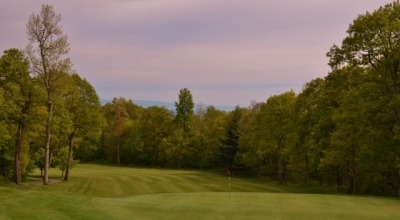 |
| Devil's Knob is the course closest to your home-away-from-home up on the mountain - the perfect setting for a late afternoon trip around the links after golf school. Here, the par four 11th hole. |
The Couples Golf School also includes golf (on your own) in the afternoon for those wanting to try out their newfound moves on the golf course, and there is plenty of good golf waiting to test your skills. Wintergreen offers 27 Rees Jones designed-holes at its Stoney Creek facility, which is down in the valley below the resort (and is also where the Golf Academy is located) – and an 18-hole Ellis Maples-designed course up near the resort center, at Devil’s Knob.
The Couples school package also includes a couples massage, for those desiring a little ‘after-school’ relaxation, and a good way to work out the kinks in all those muscles you hadn’t used much before (at least in terms of your golf swing).
In terms of accommodations, you’ll literally feel right at ‘home’ at Wintergreen, with the opportunity to rent luxuriously appointed condos – or even a home, as we stayed at. Ours was a four-bedroom house with all the comforts of our own home, and even easy access to all of Wintergreen’s outdoor delights.
We often travel as a family, and we particularly enjoy preparing meals at ‘home’ after a full day on the golf course, and Wintergreen’s accommodations generously allow for our preferences. And for those who wish to leave the cooking (and cleaning) duties behind with the rest of your troubles, there are more than enough eateries waiting just a short drive away.
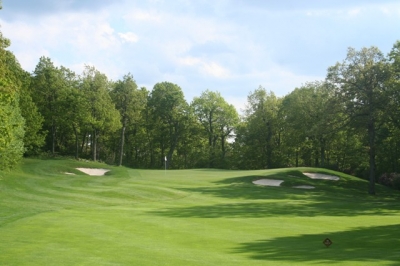 |
| Devil's Knob is known for its excellent playing conditions - and it isn't bad in the aesthetic sense, either. Here, the par four 13th hole. |
In addition, the resort’s convenient shuttle service will take you wherever you want to go up on the mountain, so you can leave the car in the driveway as well.
Wintergreen truly is one of the most complete golf destinations in the Mid-Atlantic, a place we’ve enjoyed time and time again – and look forward to going back, possibly for a tune-up on our golf skills.
Details:
Wintergreen Resort
Route 664
Wintergreen, VA 22958
The Golf Academy’s email address: gredgrave@wintergreenresort.com
The Wintergreen Golf Academy’s web page: http://www.wintergreenresort.com/Golf-Academy/
For more information or to register for the Wintergreen Golf Academy, please call 434-325-8255.
Golf packages: http://www.wintergreenresort.com/Golf-Packages/
You can also find a wealth of good information on Wintergreen’s golf programs and general information about the resort at: http://www.wintergreenresort.com/
Consult the Wintergreen Website for schedules and directions to the resort.
| Related Links | Comments on this article? | |
|
Maryland National Golf Club Hollow Creek Golf Club Rocky Gap Resort PB Dye Golf Club in Ijamsville Whiskey Creek Golf Club |
E-mail Jeff Rendall, Editor: jrendall@golftheunitedstates.com |











